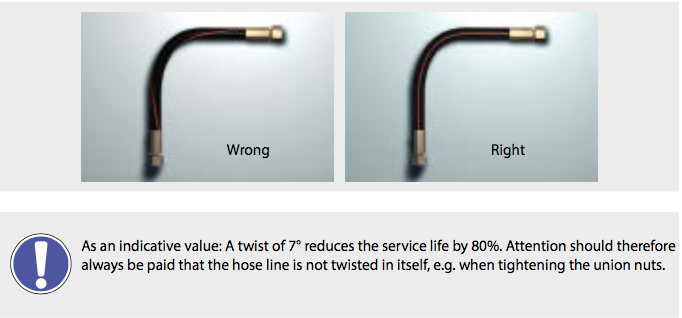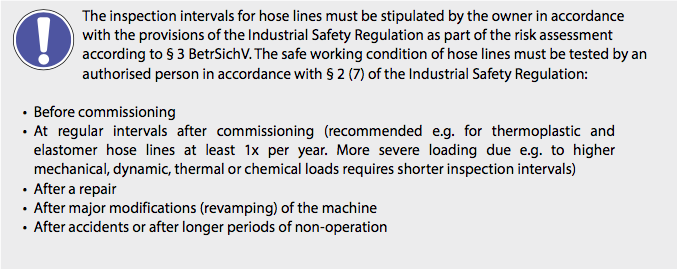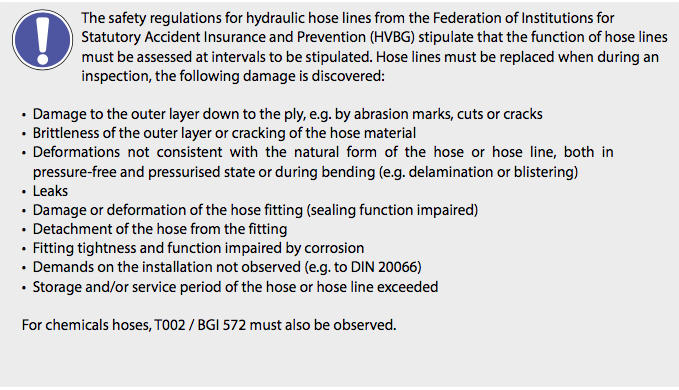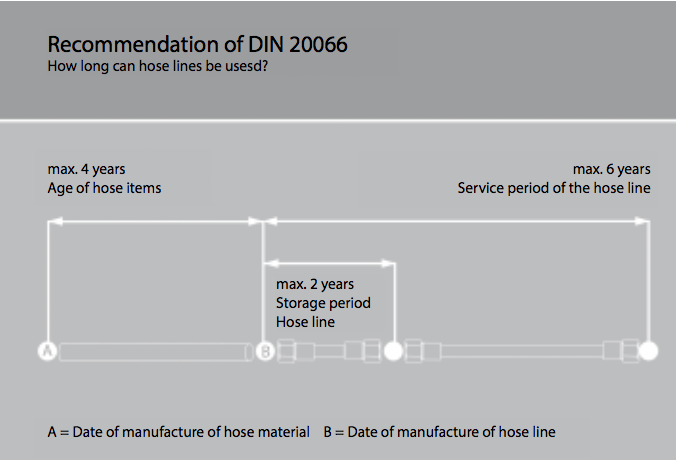
Technical Information
Industrie hose lines
1. Assembly
1.1 FUNDAMENTAL GUIDELINES FOR THE ASSEMBLY OF HOSE LINES
In order to ensure the safe function of hose lines and to avoid shortening their service lives by additional loads, the following requirements have to be satisfied:
- Hose lines may be assembled only by appropriately qualified personnel
- Hose lines must be installed in such a way that they are accessible at all times and are not obstructed
in their natural position and movement - Hose lines must generally not be subjected to torsion or compression by external influences during
operation - The smallest bending radius of the hose stipulated by the manufacturer must not be exceeded
- Hose lines must be protected against damage caused by external mechanical, thermal or chemical
influences - Before starting operation, check separable connections for tightness
- Do not put the hose line into operation in the event of obvious external damage
- If necessary, clean the hose line in a suitable manner before starting operation
- For hose lines requiring equipotential bonding in accordance with BGR 132, check the equipotential
bond and establish, if necessary - The hose line length must be determined according to the installation conditions
- The possible shortening or lengthening under pressure indicated by the supplier or in the respective
hose standard must be taken into consideration
Please note: Operation conditions with simultaneous maximum working pressure, maximum temperature and minimum bending radius shorten the service life of hose lines!
1.2 ADDITIONAL INFORMATION ON THE ASSEMBLY OF HOSE LINES
1.2.1 SELECTION OF THE HOSE LINE
The right choice of hose lines is of crucial importance for safe and cost-effective operation of a system. Criteria for the choice and design of the hose line are:
1.2.2 MEDIA COMPATIBILITY
The compatibility of the hose and fitting materials used with the media to be transported must always be tested. The surrounding media must also be taken into consideration in the selection.
1.2.3 TEMPERATURE AND ENVIRONMENT
The operating and also the ambient temperatures to be expected must be taken into consideration when selecting a hose line. If hose lines are used outside their permissible temperature range, a significant reduction in their service life is to be expected.
Note also that the outer layer of a rubber hose is susceptible to environmental influences, such as ozone or strong UV radiation. Ozone and UV radiation can break down the chain molecules of the elastomer material. As a result, the material loses its elasticity. It becomes hard and brittle and breaks at points subject to higher loads, e.g. the outer radii. Characteristics of this behaviour are radial cracks that extend down to the braiding.
1.2.4 PERMISSIBLE PRESSURE
The maximum working pressure (dynamic working pressure) determines the structure and the choice of the hose. Depending on the application, hoses are available with textile braiding, with wire braiding, with wire spiral inserts or also as special hoses of metal or PTFE.
1.2.5 NOMINAL SIZES
In a system, the hose or pipe inside diameter plays an important role. When a liquid flows through a line, it undergoes a pressure loss the depends on the type of flow, the roughness of the line inner wall, the line length, the inside diameter, the specific gravity of the liquid and its flow velocity. This applies for a continuous pipe flow. Also to be observed, however, is a "starting distance" which has a significant influence on the velocity distribution. Pressure losses also occur when the liquid flows through fittings, valves, elbows and other constrictions.
As a rule of thumb: In order to minimise losses, the inside diameter or free cross-section of the pipe / hose should be chosen large enough. If in doubt, decide in favour of the next-larger diameter. This reduces the flow velocity, and hence also the pressure losses in the line.
1.2.6 TORSION
If a hose line is installed so that it is twisted in itself, the service life is significantly reduced by the constant rubbing together of the plies. Under pressure pulses, the plies try to return to their neutral starting position. A particular load occurs in the area of the connection.
- Resistance to the medium – and not forgetting the cleaning processes!
- Temperature resistance – check also the temperature/pressure behaviour!
- Special environmental conditions and influences from the outside
- Pressure resistance, including required safety margins (also vacuum behaviour)
- Nominal sizes and the resulting flow velocities
- Bending radii
- Changes in length and outside diameter
- Exceptional loads due to external forces or pressure surges
- Abrasion behaviour and possible protection
- Availability of the hose as yard goods and of the fittings
- Installation conditions, e.g. movements, kinking, whipping, marking, torque angle of elbow
fittings, leg lengths - Safe seal shapes
- Demanded approvals
1.2.7 MINIMUM BENDING RADIUS
A permissible bending radius is prescribed for each hose type, depending on its nominal size. If the minimum bending radius is exceeded, the service life and the load-bearing capacity of the hose line is reduced, as gaps can be caused in the braiding on the outside of the bend due to the larger area to be covered. These can then result in violently spraying oil. On the inside of the bend, the opposite effect occurs: The plies are compressed and therefore no longer lie close enough to the inner layer of the hose and thus lose their pressure-bearing properties. Exceeding of the minimum bending radius occurs particularly immediately behind the connection when a hose is bent too sharply.
The same applies to hoses that are laid too close together. The hoses rub against one another. The braiding is no longer protected against external influences and failure of the hose is only a question of time. Should it not be possible to rule out abrasion, it is possible e.g. to use hoses with abrasion protection.
1.2.9 TENSILE LOAD
Tensile loads on hose lines must be avoided, as this endangers the secure connection to the fittings. Please note that hose lines can shorten under pressure (by up to 4% under maximum permissible working pressure), so that they should always be laid with a certain amount of slack. Possible movements of the hose lines must also be considered.
Note: With certain applications, e.g. spring-loaded tensioner rollers, tensile loads cannot be avoided. In such cases the permissible operational loads must be agreed upon with HANSA-FLEX.
1.2.10 HOSE HOLDERS
Hose holders should not be used where they hinder the natural movement and change in length of the hose. The outer layer will be destroyed in the long term by the rubbing movements in the holder. Hose holders should therefore only be installed on straight sections.
1.2.11 WHIPPING
If damage to a hose line is likely to present a hazard due to whipping, the hose line must be restrained or shielded. The hazardous whipping in the event of a hose line fracture can be prevented by design engineering measures. The HANSA-FLEX Stopflex safety system that permits a safe connection between hose and machine parts is particularly suitable for both proactive and subsequent installation.
1.2.12 LEAKS
If damage to a hose line creates a hazard due to the escape of the pressurised medium, the hose must be shielded.
1.2.13 COLD FLOW
Despite the chemical and physical cross-linking, creeping of the rubber material between nipple and fitting is also to be observed. This viscoelastic behaviour leads to leaks in the fitting area and to "wandering" of the hose fitting. The screws of clamp fittings or screw clamps should be checked at regular intervals.
1.2.14 GASES AND VAPOURS
When selecting the hose, attention must be paid to permeation or effusion, i.e. the possible wandering of the gas molecules through the inner layer. Media losses or undesirable concentrations of gases or gaseous fuels are the result. These gases are potentially flammable, explosive or toxic. A selective discharge of possible gas concentrations below the outer layer can be achieved by pricking, as employed e.g. for compressed air lines above 16 bar or for hot water hoses.
2. Operation
2.1 COMMISSIONING AND INTENDED USE OF HOSE LINES
Before commissioning, the tests prescribed by the relevant laws and directives (e.g. acceptance test, pressure test, etc.) and technical, organisational and personal protection measures have to be carried out. Technical and organisational measures always have priority. If all the hazards can nevertheless not be rule out, effective personal protection equipment must be provided and used. The owner must test the suitability of the hose lines and their components with respect to the operating parameters, such as operating temperature, vacuum, pressure and material resistance. Where abrasion is possible, wear of the hose line must be assessed and examined.
2.2 STORAGE OF HOSE LINES
- Store cool, dry and away from dust. Protect from direct sunshine and/or UV radiation. Shield from nearby heat sources. Do not allow hoses and hose lines to come into contact with materials that could damage them
- Store hoses and hose lines horizontally in a stress-free and kink-free condition. When stored as rings, the radius must be not smaller than the minimum recommended by the manufacturer
- Hose ends must be sealed with caps to protect the inside of the hose from dirt, ozone and corrosion
- Maximum storage period as a recommendation: 4 years for hose material and 2 years for hose lines
- Metal and PTFE hose lines must be protected in particular from exposure to chlorides, bromides, iodides and from rust
2.3 Additional Information on the storage of hoselines
2.3.1 GENERAL
Under unfavourable storage conditions or with improper handling, most products made from rubber change their physical properties. This can lead to a shortening of their service life. The changes can be caused by the effects of e.g. oxygen, ozone, heat, light, moisture, solvents or storage under strain. Properly stored and handled rubber products retain their properties almost unchanged over a long period of times (several years). The same does not apply, however, to non-vulcanised rubber blends.
2.3.2 STORAGE AREA
The storage area should be cool, dry, dust-free and moderately ventilated. Storage outdoors protected from the weather is not permitted. Solvents, fuels, lubricants, chemicals, acids, disinfectants, etc. must not be stored in the same area.
2.3.3 TEMPERATURE
The temperature for the storage of rubber products depends on the goods to be stored and the elastomers used. Rubber products should not be stored below –10°C and not above +15°C. In exceptional cases the storage temperature may be as high as +25°C by agreement with the manufacturer. Higher temperatures are only permitted for short periods. In deviation from this, a storage temperature that must not be lower than +12°C may be required for rubber products made from certain rubber types, e.g. chloroprene rubber.
2.3.4 HEATING
In heated storage areas, the rubber products must be shielded from the heat source. The distance between heat source and stored goods must be at least 1 m. A larger distance is necessary for air-heated areas.
2.3.5 MOISTURE
The storage of rubber products in damp rooms should be avoided.
Ensure that no condensation occurs. The relative humidity should preferably be below 65%.
2.3.6 LIGHTING
Rubber products should be protected from light, in particular from direct sunlight and strong artificial light with a high ultraviolet level. The windows of the storage areas should therefore be painted with a red or orange (on no account blue) protective coating. Lighting with normal bulbs should be preferred.
2.3.7 OXYGEN AND OZONE
Rubber products should be protected from air circulation, but particularly from draughts, by sheathing, by storage in airtight containers or by other means. This applies in particular to articles with a large surface area in relation to their volume, e.g. rubberised fabrics or cellular articles. As ozone is particularly harmful, the storage areas must contain no ozone-generating equipment, such as electric motors or other machines that may generate sparks or other electric discharges. Combustion gases and vapours that may result in the formation of ozone due to photochemical processes must be removed.
3.3 REPAIR AND PAINTING OF HOSE LINES
A repair of the hose line involving the continued use of the installed hose and/or fitting (integration area) is not to be recommended. Recoating of hose lines violates the identification requirement.
3.4 Additional information on the maintenance of hose lines
3.4.1 CLEANING
Rubber products can be cleaned with soap or warm water. The cleaned articles must be dried at room temperature. After prolonged storage (6 to 8 months), the products can be cleaned using a 1.5% bicarbonate of soda solution. Rinse off the residues of the cleaning fluid with clean water. Effective and particularly gentle cleansing agents are recommended by the manufacturer. Solvents such as trichloroethylene, carbon tetrachloride and hydrocarbons must not be used for cleaning. The use of sharp objects, wire brushes, emery cloth, etc. is also forbidden for cleaning. Rubber/metal compounds should be cleaned with a glycerine/ethyl alcohol mixture (1:10). If disinfection is necessary, this should be carried out after thorough cleaning of the rubber products. The disinfectant must not be used at the same time as a cleansing agent. Pay attention to the compatibility with the rubber when selecting the disinfectant. Oxygen-releasing or halogen-releasing agents such as potassium permanganate or bleaching powder, in particular, can cause damage especially to thin-walled products. Only the disinfectants recommended by the manufacturer may be used for rubber products for medical applications. The serviceability of certain rubber products can be prolonged by a special coating (wax emulsion, shellac, etc.). Such coatings are not to be recommended for rubber products for medical applications. We should point out that special cleaning and storage processes are necessary in the case of demands for silicon-free materials.
3.4.2 SERVICE PERIOD
By reference to the currently valid issue of DIN 20066 for hydraulic hose lines:
Even with proper storage and admissible loading, hoses and hose lines are subject to natural ageing. Their service period is therefore limited. Improper storage, mechanical damage and overloading are the most frequent causes of failure. In individual cases, the service period can be defined on the basis of empirical values and in deviation from the following indicative values:
- During production of the hose line, the hose material should not be older than four years
- The service period of a hose line, including a possible storage period of the hose line, should not exceed six years
- The storage period of the hose line should therefore not exceed two years
The following diagram illustrates this principle:
In practice, hoses are stored according to the First In-First Out (FIFO) principle. FIFO defines a storage principle where the date of storage determines the date of retrieval from storage. This means that the hose that has been in storage longest is retrieved from storage first.
Information on the storage and service periods of hose lines can be found in the following publications:
- DIN EN ISO 4413, point 5.4.6.5.1 - Hose lines (General requirements)
- DIN 20 066, point 14.1.2 - Storage and service period (recommendation)










